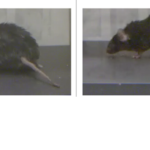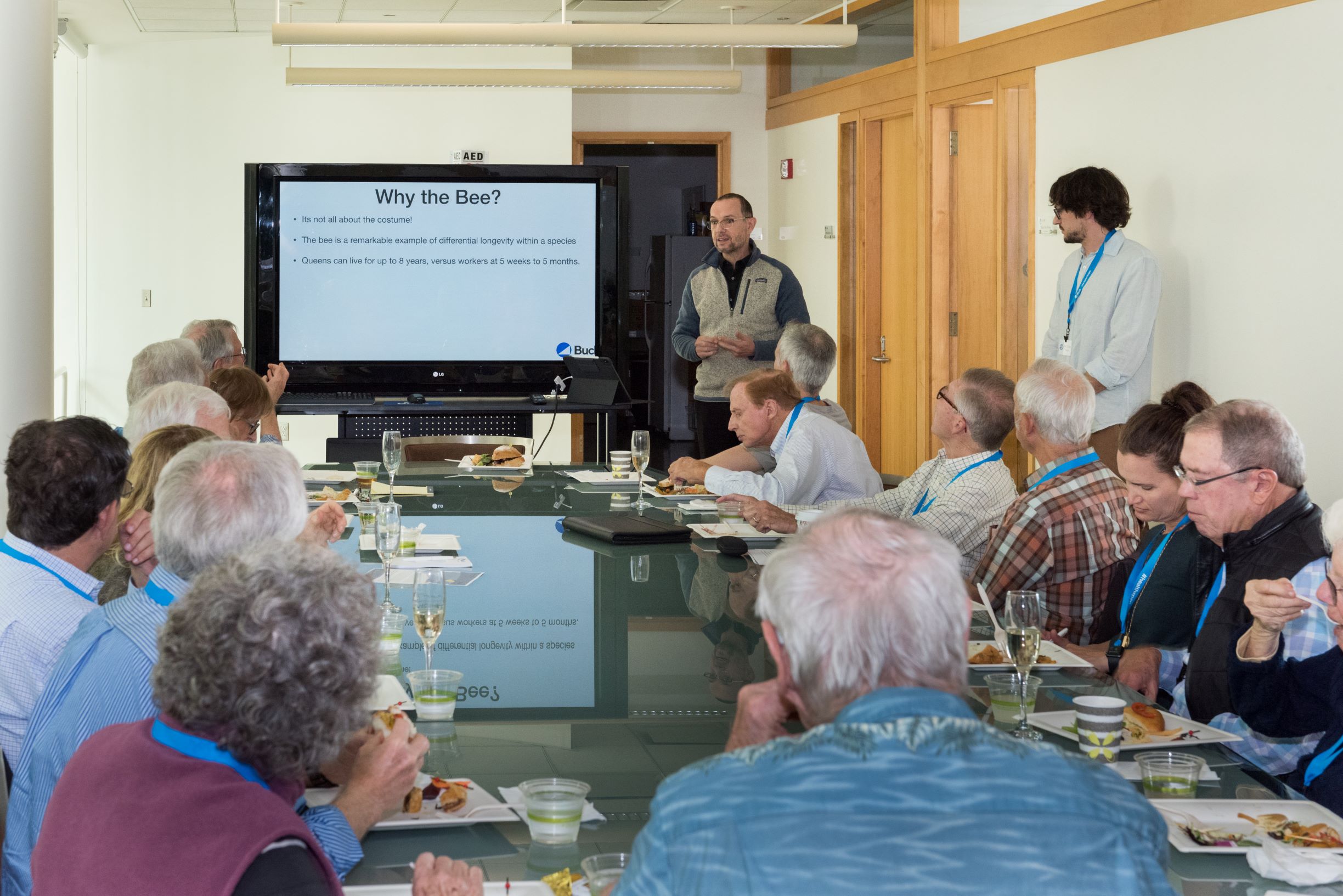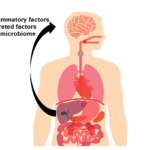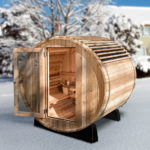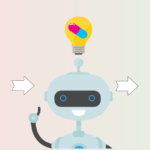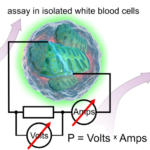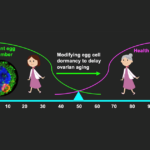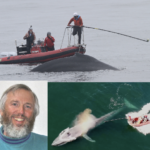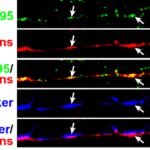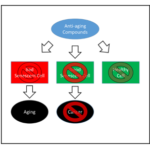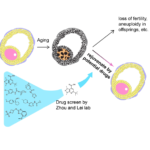IMPACT CIRCLE
CENTER DETAILS
BUCK BEES
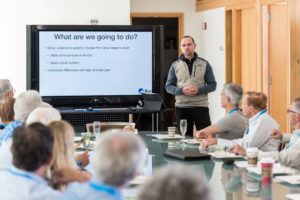 Last year’s Circle Members awarded Simon Melov the grand prize for his project that aims to figure out why Queen bees and worker bees, which are born genetically identical, have such discrepant lifespans. Queen bees live seven years and workers only seven weeks. Queen bees progress in exactly the same way as workers until day four of their lives, when queens acquire more food. Melov hopes to determine the influence of diet on the epigenetic and gene expression profiles of bees as they differentiate into either queens or workers.
Last year’s Circle Members awarded Simon Melov the grand prize for his project that aims to figure out why Queen bees and worker bees, which are born genetically identical, have such discrepant lifespans. Queen bees live seven years and workers only seven weeks. Queen bees progress in exactly the same way as workers until day four of their lives, when queens acquire more food. Melov hopes to determine the influence of diet on the epigenetic and gene expression profiles of bees as they differentiate into either queens or workers.
Eight months after bestowing the grand prize, Circle Members reunited at the Buck for an update. With money from the Grand Prize, Simon purchased upwards of 30,000 bees and built a compound of four bee houses for them on the roof of the Buck. Circle Members climbed up to the roof to see them for themselves. To “keep” the bees, Simon has brought on Nic Martin, PhD, also from Australia. Nic is not your ordinary beekeeper; his PhD was devoted to changing features of worker bees to extend their lifespans. He got as far as a 40 percent increase in one experiment! Simon was able to recruit Nic thanks to the Impact Circle.
What is the impact of the Impact Circle? Our donors come back, year after year, anxious to learn and participate. And our scientists are raring to go every year because, it turns out that the Impact Circle has provided a lot of bang for the Buck scientist.
Up-ending the Scientific Status Quo
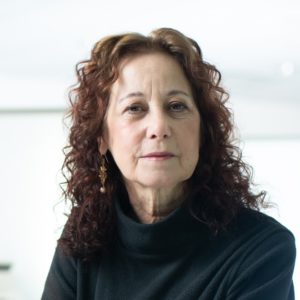 The first winners of the Impact Circle, Judy Campisi and Julie Andersen, used their funding to carve out entirely new scientific territory. Campisi is the world’s leading authority on cellular senescence – the process by which cells cease to divide, then accumulate and secrete toxins – and its role in aging. Yet she had never considered that cellular senescence might happen in the brain because most neurons do not divide to begin with. Andersen, a neuroscientist renowned for her expertise in Parkinson’s disease (PD), proposed that they investigate whether cellular senescence occurs in the brain and, if so, whether it is linked to PD.
The first winners of the Impact Circle, Judy Campisi and Julie Andersen, used their funding to carve out entirely new scientific territory. Campisi is the world’s leading authority on cellular senescence – the process by which cells cease to divide, then accumulate and secrete toxins – and its role in aging. Yet she had never considered that cellular senescence might happen in the brain because most neurons do not divide to begin with. Andersen, a neuroscientist renowned for her expertise in Parkinson’s disease (PD), proposed that they investigate whether cellular senescence occurs in the brain and, if so, whether it is linked to PD.
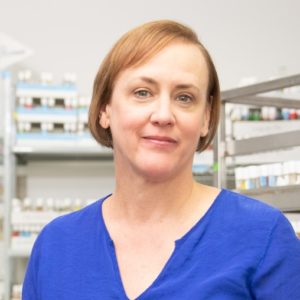 “We had submitted grants on the topic to the NIH and got rejected again and again,” recalls Andersen. “I assume it was because people in the aging field knew of cellular senescence, but people in neuroscience had no idea what it was.” Now they do, thanks, in part, to the Impact Circle. Andersen and Campisi were able to initiate experiments with the money from the Impact Circle. The results from those experiments led to more funding from the NIH and then from the Michael J. Fox Foundation. “Basically, all that work ended up in Cell Reports in January of 2018 as the first paper to show that if you knocked out senescent cells in the brain, it prevented an age-related neurodegenerative disease – Parkinson’s,” says Andersen.
“We had submitted grants on the topic to the NIH and got rejected again and again,” recalls Andersen. “I assume it was because people in the aging field knew of cellular senescence, but people in neuroscience had no idea what it was.” Now they do, thanks, in part, to the Impact Circle. Andersen and Campisi were able to initiate experiments with the money from the Impact Circle. The results from those experiments led to more funding from the NIH and then from the Michael J. Fox Foundation. “Basically, all that work ended up in Cell Reports in January of 2018 as the first paper to show that if you knocked out senescent cells in the brain, it prevented an age-related neurodegenerative disease – Parkinson’s,” says Andersen.
The Gift That Goes on Giving
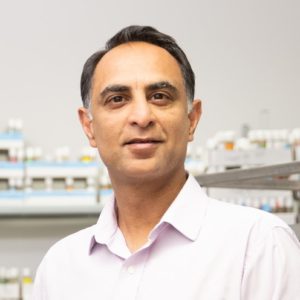 Likewise, Pankaj Kapahi was recently awarded a National Institutes of Health (NIH) RO1 grant, one of the institute’s largest and most prestigious, for a study that combines all three of his Circle projects. With the grant, Kapahi is exploring why people with diabetes are at two times the risk of Alzheimer’s disease. He hypothesizes that the accumulation of advance glycation end products (AGEs) – toxic byproducts of glucose metabolism that are more prevalent in people with diabetes – are to blame for the neurodegeneration that develops.
Likewise, Pankaj Kapahi was recently awarded a National Institutes of Health (NIH) RO1 grant, one of the institute’s largest and most prestigious, for a study that combines all three of his Circle projects. With the grant, Kapahi is exploring why people with diabetes are at two times the risk of Alzheimer’s disease. He hypothesizes that the accumulation of advance glycation end products (AGEs) – toxic byproducts of glucose metabolism that are more prevalent in people with diabetes – are to blame for the neurodegeneration that develops.
“The Circle supported the preliminary work it took to get NIH funding,” says Kapahi. “Our NIH grant wouldn’t have been possible without it.” Circle funding has had a fundamental impact on his career. “The Impact Circle pushed my lab in a whole new direction,” adds Kapahi. Prior to his wins, his lab was focused primarily on dietary restriction. “This seed funding has helped us create more far-reaching connections with diseases like Parkinson’s,” he says.
Building Community
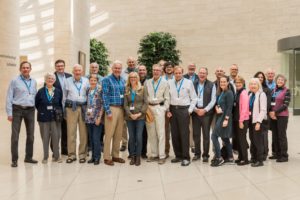
Our Impact Circle, like all circles, is ongoing. Winners continually apprise Circle Members of their progress. Indeed, six months after Campisi and Andersen won, they got together with Circle members to celebrate and share their work. “It’s so nice to be able to interact with people on a personal level about your work,” says Andersen. “The Circle Members have been so supportive and it is really so nice knowing that they believe in us.”
Previous Winners:
2014 Judy Campisi and Julie Andersen
2015 Dale Bredesen and Brian Kennedy
2016 Julie Andersen and Pankaj Kapahi
2017 Pankaj Kapahi and John Newman
2017 Jennifer Garrison and Birgit Schilling
2018 Pankaj Kapahi and Neelanjan Bose
2019 Simon Melov and Nicolas Martin
Blood brain barrier: The blood–brain barrier is a highly selective semipermeable border of endothelial cells that prevents toxins in the circulating blood from crossing into brain.
Glycation (sometimes called non-enzymatic glycosylation) is the attachment of a sugar to a protein or lipid. Typical sugars that participate in glycation are glucose, fructose, or their derivatives. Glycation is a biomarker for diabetes and is implicated in some diseases and in aging.
Human induced pluripotent stem (iPS) cells: are derived from skin or blood cells that have been reprogrammed back into an embryonic-like, undifferentiated state that enables the development of any type of human cell needed for therapeutic purposes. Shinya Yamanaka of the Gladstone Institute and UCSF, received a Nobel for discovering them. They have transformed biological research. iPS cells can be developed into organoids, which are miniaturized and simplified version of an organ produced in vitro in three dimensions that show realistic micro-anatomy. Organoids made from human tissues allow scientists to study the effectiveness of novel therapeutics in a safe, inobtrusive and precise way.
Intergenerational – existing or occurring between generations. Example: Research has shown the impact of polychlorinated biphenyls (PCBs) – chemicals that were used in electrical equipment starting in the 1920’s – across generations. Although they have been phased out of production, PCBs are still being released into the environment from preexisting applications and improper disposal of products that contain them. Because of their chemical stability and transportability, they accumulate in the food chain, enter our food supply, and pass from mother to infant in utero and during breastfeeding, with potentially harmful effects on the endocrine, immune, nervous, and reproductive systems.
Synapse – the space between two neurons where chemical substances are retained to transfer electrical signals from one neuron to another.
T-cells – is an immune cell, made in the bone marrow, that attacks virus-infected cells, foreign cells and cancer cells. The T in T-cells stands for thymus, an organ at the front of the trachea, where T-cells mature.
Tau – is a protein shaped like a tube that transports nutrients from one nerve cell to another. Damaged and misshapen tau are found in multiple forms of brain disease, including Alzheimer’s disease, chronic traumatic encephalopathy, Pick disease, frontotemporal dementia with parkinsonism-17, progressive supranuclear Palsy, and corticobasal degeneration.
Lisa Palma
Director, Office of Philanthropy
LPalma@buckinstitute.org
415-2092027
THE CONTENDERS
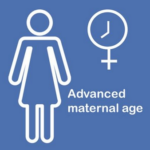
Intergenerational Effects of Advanced Parental Age on Reproductive and General Health Outcomes
